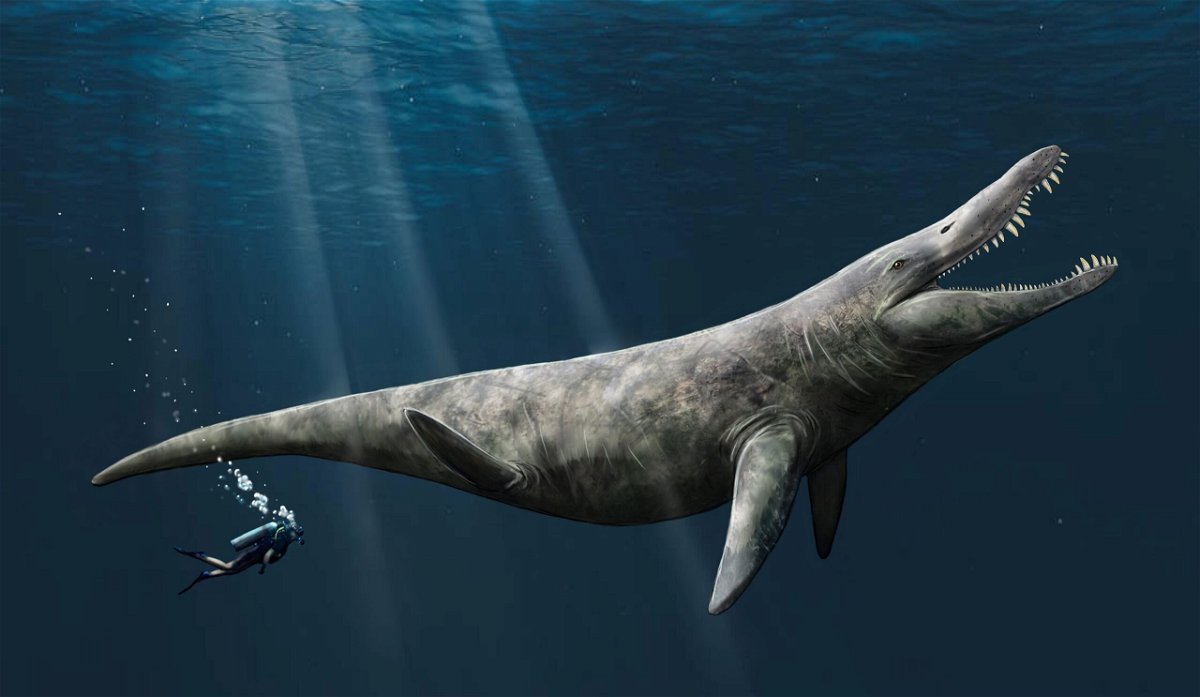Size of a Jurassic sea giant found due to fossil discovery, study says

Artwork by study coauthor Megan Jacobs imagines what a large Late Jurassic-age pliosaur would have looked like.
By Kristen Rogers, CNN
(CNN) — The chance discovery of large fossil specimens in a museum drawer have led researchers to conclude there was a gigantic marine reptile called a pliosaur swimming the seas 152 million years ago, according to a recent study.
The findings from the Late Jurassic period, though fragmentary, suggest the pliosaur was about twice the size of a killer whale — and move lead study author David Martill closer to redemption. That’s due to what many researchers considered inaccurate claims he made about the size of another pliosaur in the BBC’s 1999 television documentary series “Walking With Dinosaurs.”
One of the episodes “showed a 25-metre long Liopleurodon,” which “sparked heated debates … as it was thought to have been wildly overestimated and more likely to have only reached an adult size of just over six metres long,” according to a news release about the current study, published May 10 in the journal Proceedings of the Geologists’ Association.
Martill, who was a consultant for the episode and is currently a professor in the University of Portsmouth’s School of the Environment, Geography and Geosciences in the United Kingdom, said he got the size “horrendously wrong.”
“I based my calculations on some fragmentary material which suggested a Liopleurodon could grow to a length of 25 metres, but the evidence was scant and it caused a lot of controversy at the time,” he said in a statement. “Now we have some evidence that is much more reliable after a serendipitous discovery of four enormous (vertebrae).”
‘Very fearsome animals’
Martill recently found one of those vertebrae in a drawer of fossils at Abingdon County Hall Museum in England, and subsequently learned the curator had three more in storage. The vertebrae were large, with a maximum width of 269 millimeters (10.5 inches), maximum height of 222 millimeters (8.7 inches) and maximum length of 103 millimeters (4 inches).
Due to the size of the vertebrae and comparisons to other fossils of other species from the Mid Jurassic and Early Cretaceous periods, the researchers concluded they were closely related to pliosaurs or a similar but undescribed species, according to the study.
Topographic scans showed the reptile might have grown to between 9.8 and 14.4 meters (roughly between 32 and 47 feet) long, the authors wrote.
“Although not yet on a par with the claims made for Liopleurodon in the iconic BBC TV series ‘Walking with Dinosaurs,’” Martill added, “it wouldn’t surprise me if one day we find some clear evidence that this monstrous species was even bigger.”
Adam S. Smith, curator of natural sciences at the Nottingham Natural History Museum, Wollaton Hall, agreed.
“It isn’t out of the question that pliosaurs may have exceeded 15 metres long,” Smith said via email. However, he cautioned that an increase in length corresponds with an “exponential increase in volume … placing a biological limit on the upper size pliosaurs could reach.” Smith wasn’t involved in the study.
Pliosaurs were “a group of large carnivorous marine reptiles characterized by massive heads, short necks and streamlined tear-shaped bodies,” according to Britannica. Four large fins helped propel the ancient creatures through seas. Pliosaurs were similar to plesiosaurs, their relatives in the order Plesiosauria, but had bigger elongated heads and shorter necks.
“We know these pliosaurs were very fearsome animals swimming in the seas that covered Oxfordshire 145-152 million years ago,” Martill said. “They had a massive skull with huge protruding teeth like daggers — as big, if not bigger than, a T. rex, and certainly more powerful.
“They were at the top of the marine food chain and probably preyed on ichthyosaurs, long-necked plesiosaurs and maybe even smaller marine crocodiles, simply by biting them in half and taking chunks off them,” he added. “We know they were massacring smaller marine reptiles because you can see bite marks in ichthyosaur bones in examples on display in The Etches Collection in Dorset.”
Limitations of guesstimating size
Valentin Fischer, a professor in the department of geology at the University of Liège who wasn’t part of the study, called the findings “shaky” since lengths of cervical vertebrae — the type the authors analyzed — from pliosaurs can vary.
Another expert, however, thought estimates weren’t necessarily a bad thing.
“Scaling is always reliant on a best guess using the specimens we know,” said Andrew Cuff, a UK-based paleontologist who wasn’t involved in the study, via email. “The author in this current study seem to have done a good job comparing specimens and attempting to scale up the more complete fossil individuals so that the newly described vertebrae would fit. Whether the 14.4m is realistic or possibly too large will require more complete specimens to confirm for sure but I wouldn’t be surprised if a pliosaur that large did swim the Jurassic seas.”
The vertebrae were initially found during excavations at Warren Farm in the River Thames Valley near Abingdon in Oxfordshire, and derive from the Kimmeridge Clay Formation, according to the study.
“This kind of discovery reminds us that there were some amazing animals in the past,” Michael Benton, a professor of vertebrate paleontology at the University of Bristol in the UK, said via email. Benton wasn’t involved in the study. “Here is a marine reptile as large as a sperm whale, and there’s nothing like it around today.”
The-CNN-Wire
™ & © 2023 Cable News Network, Inc., a Warner Bros. Discovery Company. All rights reserved.
